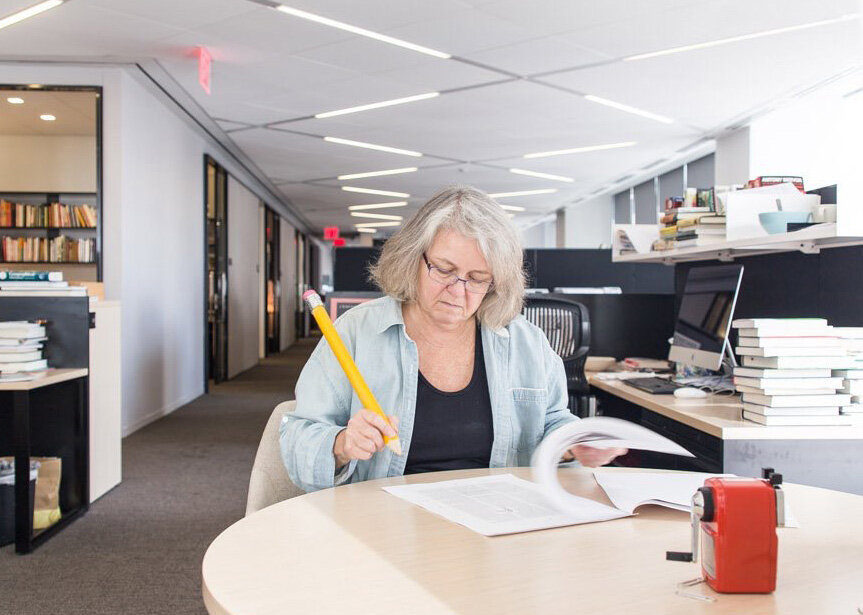Giant Pencil Interviews Mary Norris, the Comma Queen
Our own mascot, Giant Pencil, met up with author and copy editor extraordinaire Mary Norris at the ACES 2019 conference in Providence, RI, to chat about her latest book, Greek to Me.
Mary Norris and Giant Pencil pose with Mary's new book. Photo by JW.
Giant Pencil: You’ve spoken lovingly about your favorite pencils in numerous past interviews, but have you ever been interviewed by an actual pencil?
Mary Norris: This is the first time I have been interviewed directly by a pencil, but I have shot a video in a pencil boutique and had its owner, Caroline Weaver, splay an array of gorgeous pencils in her well-manicured hands for my admiration. If you don't know C.W. Pencil Enterprise, you're in for a treat.
GP: In Greek to Me, you discuss how learning Greek and traveling to Greece helped sharpen your English knowledge. What is one useful Greek word or phrase (ancient or modern) that all editors should know?
MN: The Greek for "O.K." is entáxei (εντάξει), pronounced "enDOXy" (rhymes with "epoxy," if I am pronouncing that right). The literal meaning is "in order": the prefix for "in" is en (εν) and taxei (τάξει) is a form of the noun that means (among other things) class, as in classroom at school, where everyone sits in order and things are under control (supposedly). We cannot do without "O.K." in English. In Greek, it's a very reassuring word.
GP: What other fine points do you think the editorial types will enjoy most about your new book?
MN: Writers and editors and all word nerds enjoy the alphabet, and I have a chapter at the beginning of the book in which I did my best to write something interesting about it. It's about the Greek alphabet as the ancestral alphabet of English. I started out writing an abcedarian for the barbarian (Alpha is for Athena, Beta is for Bios, etc.), but it kept putting me to sleep, so I jumped all the way to chi and omega and had fun with fraternity names, Sigma Tau Delta (STD), of which I am an honorary member. I think people who like words will enjoy the prospect of a new alphabet.
Mary Norris at work with her own giant pencil (no relation). Photo by Arthurious.
GP: Erasing the thought that editing—as we know it today—didn’t really exist in ancient times, how do you think you would have fared as an editor of ancient Greek epigraphs? You’ve edited many famous authors in The New Yorker, but how would you have marked up, say, an early written version of the Iliad?
MN: It's a little hard to edit something that is written in stone. If it has a mistake, do you fix it or preserve it? I wouldn't want to draw attention to it . . . I think I'd be paralyzed by the idea of editing epigraphs. The epic poems are more forgiving. Once they were written down, some of the repetition in them was no longer necessary, but it is part of their fabric, and if I changed anything, I would immediately change it back. I hope.
GP: What was it like to be on the author’s end of the editing process for your books? Was it difficult to quiet your inner editorial markup while writing?
MN: I am an obsessive reviser. I like to buff the prose. I can be very critical of my own writing. I often think of Chaucer, who didn't have a lot of paper to make rough drafts on. He must have had the verses all thought through before committing them to paper. The word processor is a blessing and a curse: it makes it too easy to write a lot of crap. The writing goes better for me if I start out in pencil on paper and write down everything. Then I go back and type it up, print it out, and go at it with a pencil again, revising. At some point, while I am typing notes, I end up revising on the keyboard. But I am always printing things out and finding more to do.
As I had not had a lot of success getting things published before Between You and Me, I was thrilled to be working with an editor. I'm one of those writers who can't see the forest for the trees—I love details, and detours, and my editor sees the whole picture and encourages me to be more direct. He also helps with pacing. Being copy-edited is something else again. I am grateful for catches—typos, misspelled names, repetitions—but anything that messes with the writer's voice, that the writer is surprised to hear herself saying, needs to be politely rejected.
GP: Do you have any other book ideas in the works? I know some fantastic writing implements if you need inspiration . . .
MN: I would love to write a third book and will look deep into my soul for a subject that will keep me interested for the length of time it takes to write a book, which is at least two years of actual writing preceded by decades of observation and research. It has to be a subject I love. Here's hoping! I have lots of pencils and know where to get more, so that's OK. Thanks!
Find out more about Mary Norris and her books at her Comma Queen website, or follow her on Twitter or Instagram.
Pacific Northwest word nerds can catch Mary live in Seattle on May 1, hosted by Town Hall, and in Portland on May 3, hosted by Live Wire. The Guild will be organizing social gatherings before each of these events, which can be found on our events calendar.


